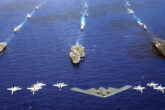August 18, 2021
From Desert Storm to Inherent Resolve: The Evolution of Airpower
On June 27, U.S. fighter jets struck weapons storage facilities used by Iranian proxy groups Kataib Hizballah and Kataib Sayyid al-Shuhada in retaliation for launching drone attacks on U.S. military facilities in the region. This was the second set of airstrikes ordered by the Biden administration in order to deter Iran and its proxies from attacking U.S. equities in the Middle East.
Just several weeks later, U.S. airpower was used once again, but this time in Afghanistan. “Over-the-horizon” airstrikes sought to bolster Afghan defenses, blunt the Taliban’s momentum, protect key urban areas, and stave off the collapse of the Afghan state.
Presidents and their advisers should be mindful that, although innovations in warfighting may achieve tactical and operational aims, they do not guarantee strategic success.
President Joe Biden’s decision to use fighter jets to strike Iranian infrastructure in Syria and Iraq, and to defend key Afghan cities, follows a familiar pattern. Since the 1991 Gulf War, U.S. presidents have chosen time and time again to use airpower to protect U.S. interests abroad. Since the six-week air campaign that immobilized and demoralized Saddam Hussein’s forces defending Kuwait, airpower has become the centerpiece of U.S. military interventions in Bosnia and Herzegovina, Kosovo, Afghanistan, Libya, and, once again, Iraq.
The U.S. airstrikes against Iranian-backed militia groups located along the Iraqi-Syrian border, and the uptick in American air support to Afghan forces, demonstrate how the model of airpower perfected against the Islamic State in Iraq and the Levant (ISIL) in Iraq and Syria has evolved. But the limited strikes on Iranian proxies and Taliban forces stand in stark contrast to the continued strikes on Islamic State leaders and targets in Iraq and Syria also authorized by the Biden administration. Previous military successes are just as likely to distort policymakers’ thinking as prior failures. The Biden administration should not harbor unrealistic expectations about what airpower can achieve, nor should it succumb to the temptation to employ airpower because it is a low-risk form of taking action.
Read the full article from War on the Rocks.
More from CNAS
-
Defense / Energy, Economics & Security / Technology & National Security
The Outlook CEO Perspectives on Risk, Resilience and ReturnsJoin David Schwimmer and Richard Fontaine, CEO of the Center for New American Security, as they explore the current national security landscape and its impacts on global econo...
By Richard Fontaine
-
Are We Ready? | America’s Next Battlefield, with Thomas Shugart
Thomas Shugart, adjunct senior fellow at CNAS, sits down with James M. Lindsay to discuss how the tools and tactics of warfare have changed in the past decade and whether the ...
By Tom Shugart
-
How Are China, Ukraine and the U.S. Actually Using Military AI?
Artificial intelligence is being used on the battlefields of Ukraine right now — or is it? That’s one of the questions driving the second part of Breaking Defense's roundtable...
By Josh Wallin
-
Defense / Indo-Pacific Security
Is the U.S. Ready for War with China?U.S. military planners are caught in an impossible dilemma....
By Franz-Stefan Gady




